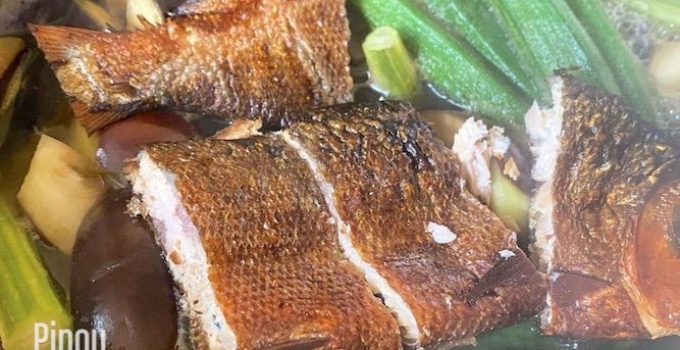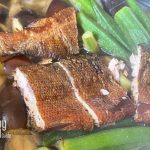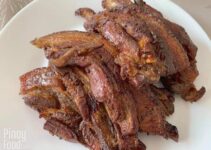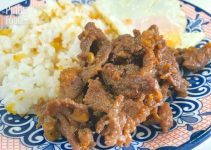Dinengdeng– An Ilocano vegetable medley cooked with grilled fish and bagoong isda (monamon).
Here is a good dish that you can whip up if you want to eat something healthy and you happen to have a couple of vegetables and a fish lying around. Or maybe you have a bunch of vegetables sitting and that’s about to expire, the Dinengdeng is one recipe you can try and it does not disappoint.
I mean, you can actually go out of your way to buy the ingredients because this is a nice cheap alternative from your everyday routine. Read the recipe article and try out this veggie dish now!
What is Dinengdeng?
Dinengdeng is a famous Ilocano grilled fish dish with vegetables. This has become famous among the common people because the vegetables used are usually the ones that grow in the backyard.
Another thing is that it is actually an easy dish you can make out of the fly. So this dish is made of a grilled/ fried fish, and milkfish is mostly the preferred choice, along with vegetables such as okra, squash, ampalaya, string beans, malunggay leaves, tomato, among others.
Dinengdeng Vs Pinakbet
Frequently mistaken for each other, dinengdeng and pinakbet are both beloved vegetable dishes from the northern region.
The two dishes share a similar group of nutritious vegetables, as well as the use of bagoong paste (either made from fish or shrimp). However, there is one key difference: while pinakbet is prepared with pork while dinengdeng is prepared with fish, making it a healthier option with fewer fats.
Another distinction between the two lies in the method of cooking. dinengdeng’s vegetables are boiled in a pot with ample water, resulting in a hearty soup. In contrast, pinakbet’s vegetables are sautéed with a little water added to prevent drying out, but not enough to create a soup-like consistency.
Ingredients You’ll Need
Fish
You can pick any available fish to go with this dish but the most common is milkfish or bangus. You can either grill or fry the before combining with the vegetables.
Vegetables
Dinengdeng calls for several vegetable and in this recipe, we will be using malunggay, squash, ampalaya, sitaw, and okra.
Bagoong
Since this is an Ilocano dish, it makes use of a unique local bagoong or fish paste called bagoong monamon.
Aside from these, we will also be using other regular pantry ingredients like onion, ginger, and tomato. If you are filling up your pantry, here’s a handy shopping guide:
Equipment You’ll Need
- Cooking Pot (Kaldero)- Dinengdeng is a one-pot dish and we will be using a regular Filipino kaldero in the whole cooking process. You can substitute any deep pan or casserole as long as it can hold the amount of liquids in this recipe.
In need of kitchen tools and equipment? Read this before you buy:
How to Cook Dinengdeng
Start off with grilling or cooking the fish. Just make sure that the fish gets cooked on both sides and is nicely browned. The goal of this dish is to let the flavors of all the ingredients blend together. Bring the water to a boil in a cooking pot and then start off by tossing in the onions, tomato, and the ginger.
After that, go and season with the bagoong isda or bagoong monamon. At this point, if you have non-leafy vegetables you can toss them in and cook for about 3 minutes or you can now drop in the cooked milkfish.
Lastly, add in the rest of the vegetables and cook until they are done. Make sure that the fish is stirred well within the dish to maximize the flavor.
Cooking Tips
- This dish uses grilled or fried fish as a staple ingredient, and for this recipe we opted to choose milk fish. This makes for an enjoyable taste that you will surely enjoy.
- However, if you want to try other kinds of fishes, you can still do so, as it is acceptable to use any variety. The most common ones used for this dish are milkfish or bangus, and tilapia.
- When grilling the bangus, it is recommended that you keep the scales of the fish. This will make it easier for you to grill because the scales prevent the fish from sticking into the grilling pan. If you want a nicer finish for the fish, you can slice it up first before grilling.
- Aside from the flavor of the dish, it is also good to think about the appearance of what you’re about to serve. Since we are using mainly vegetables here, it is important that we take time to cook these properly.
- If you are adding or switching some of the vegetables included in the recipe, just make sure that you cook the non-leafy vegetables first and then the leafy vegetables last since they’re the ones that cook quickly.
How to Serve Dinengdeng
Dinengdeng is best served warm during lunch or dinner. It is already main course and is usually served with freshly cooked white rice. But you can serve this with another fried or grilled dish and a cool drink like soda or iced tea.
How to Store and Reheat Dinengdeng
In case you have leftovers, transfer to a clean food container with lid. You can refrigerate this to extend the shelf life to 3 days. To reheat, you can either use a microwave oven or over a stove. Apply low-medium heat when reheating over a stove.
Other Ilocano Recipes
For a quick reference about this recipe, see the recipe table below:
Authentic Dinengdeng Recipe
Equipment
- Cooking Pot
Ingredients
- 2 pcs milkfish (bangus), grilled or fried
- 1 pc medium-sized onion, chopped
- 1 thumb ginger, sliced
- 2 pcs tomato, cut into wedges
- 2 cups malunggay leaves
- 1 cup squash, cut into cubes
- 1 pc bitter gourd (ampalaya), sliced
- 1 cup string beans (sitaw), sliced
- 6 pcs okra
- 3 cups water
- 3 tbsp bagoong isda (monamon)
Instructions
- In a large cooking pot, pour in water and bring to a boil.
- Add-in the onions, tomato and the ginger. Saute for 3 minutes or until soft and fragrant.
- Pour-in the bagoong isda and continue to cook for another 5 minutes.
- Add-in the milkfish. Let it simmer for 5 minutes.
- Add-in the squash, ampalaya, okra, string beans, and malunggay leaves. Cook until vegetables are done.
- Transfer to a serving tray or serving plate. Serve and enjoy!
Notes
Nutrition
Pin and save this recipe to your Pinterest account! Click on the Pin button above 🙂
Thank you and I hope you find this article useful! It’ll mean a lot if you RATE THE RECIPE by clicking the stars and SHARE THIS TO YOUR FRIENDS! 🙂




